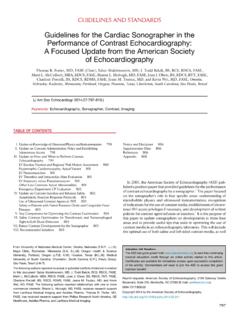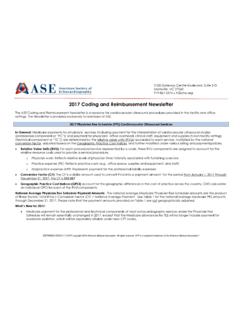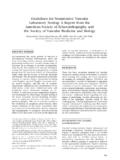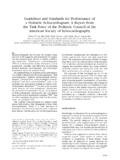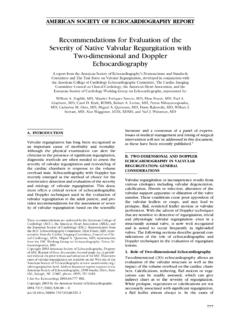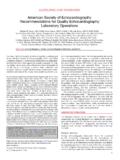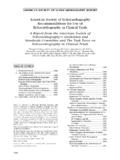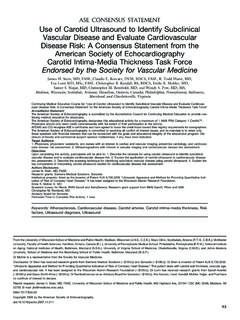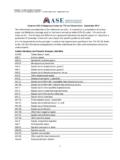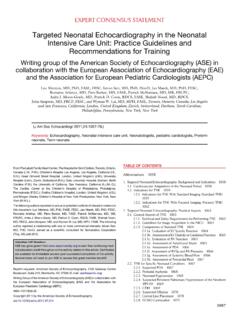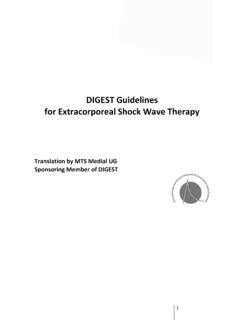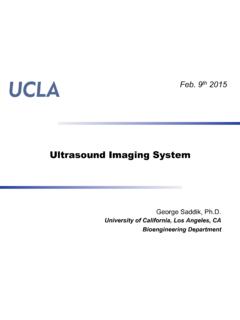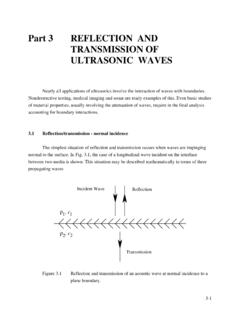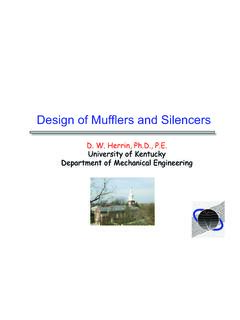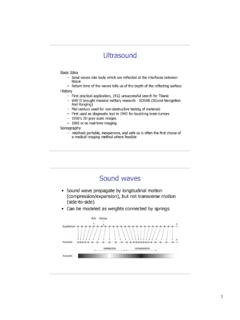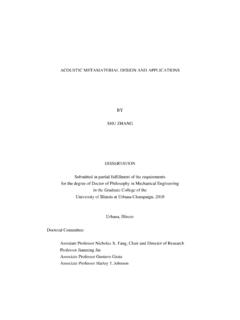Transcription of ReView ARticle Imaging Artifacts in Echocardiography
1 Downloadedfrom BhDMf5ePHKav1zEoum1tQfN4a+kJLhEZgbsIHo4 XMi0hCywCX1 AWnYQp/IlQrHD3i3D0 OdRyi7 TvSFl4Cf3VC4/OAVpDDa8K2+Ya6H515kE=on 12/30/2020 Downloadedfrom BhDMf5ePHKav1zEoum1tQfN4a+kJLhEZgbsIHo4 XMi0hCywCX1 AWnYQp/IlQrHD3i3D0 OdRyi7 TvSFl4Cf3VC4/OAVpDDa8K2+Ya6H515kE=on 12/30/2020 Copyright 2015 International Anesthesia Research Society. Unauthorized reproduction of this ARticle is 2016 Volume 122 Number 3 633 Copyright 2016 International Anesthesia Research SocietyDOI: are common during Echocardiography . An artifact is information contained in a displayed image that leads to an incorrect depiction of the true anatomy. The increased complexity in the interpretation of Artifacts has been part of the ongoing debate on the impor-tance of proper training and credentialing for ,2 For example, Artifacts in the ascending aorta occurred in 46% of patients with suspected aortic dissec-tions studied by transesophageal Echocardiography (TEE).
2 3 The misinterpretation of an artifact as a true finding may lead to unnecessary or omitted interventions, including medical treatment and ,5 This ReView is intended to discuss Artifacts by providing examples, reviewing the ultrasound physics behind their generation, and suggesting how to reduce or eliminate IMAGE FORMATIONP iezoelectric elements constitute the basic building blocks of ultrasound transducers. These elements convert elec-trical energy into mechanical vibrations that propagate through tissue as pulsed sound waves during the trans-mission phase. The distance between the beginning and the end of a pulse is called the spatial pulse length, and the pulse repetition frequency is defined as the number of pulses emitted per unit time (Fig.)
3 1). Typical echocardiog-raphy transducers transmit in the frequency range of 2 to 7 MHz. When transmitted pulses strike tissue interfaces with different acoustic impedances, some of their energy is reflected back to the transducer. The echoes returning to the transducer during the listening phase are converted into an electrical signal and processed into an image dis-played on the monitor. When the difference in acoustic impedance is high ( , bone/soft tissue interface), more of the transmitted ultrasound wave is reflected. Current Echocardiography systems assume that the ultrasound travels uniformly at a speed of 1540 m/s through soft tissues, such as the heart.
4 This speed is derived from the mean velocity through various human tissues consisting primarily of muscle6 and does not represent the speed of sound through all tissues (Table 1).However, not all the transmitted energy is reflected back to the transducer. Attenuation is the gradual loss of energy because of reflection and absorption7 (Table 2; Fig. 2). The ultrasound system accounts for the depth-dependent effects of attenuation by amplifying the signals returning later. This can also be done manually via the time gain compensa-tion allows the operator to distinguish closely spaced objects in the image display as separate structures rather than as a single one.
5 In 2D Imaging , spatial resolu-tion consists of axial and lateral resolution. Axial resolution improves as the spatial pulse length shortens. Lateral reso-lution is maximum at the narrowest part of the beam ( , focal zone). Echocardiography systems allow for adjust-ment of the depth of the focal grayscale Imaging Artifacts arise when the data acquisition and signal-processing assump-tions made by the ultrasound Imaging system are violated (Table 3); these were recently discussed by Pamnani and In evaluating Artifacts , the importance of obtain-ing multiple views of the same object cannot be stressed enough, because the persistence of a finding in mul-tiple views decreases the likelihood that it is an artifact (Table 4).
6 TWO-DIMENSIONAL ULTRASOUND ARTIFACTSS hadowing and Enhancement ArtifactAnechoic or hypoechoic regions may be the result of shad-owing. Conversely, hyperechoic areas on an image display may be the result of enhancement. In both instances, the assumption that the ultrasound is attenuated uniformly is violated. Enhancement Artifacts resulting in the appear-ance of extra-anatomic features may occur when the ultra-sound beam travels through tissue that attenuates less than its Shadowing occurs when the transmit-ting beam encounters a structure with high attenuating For example, the highly reflective portions of prosthetic or heavily calcified valves prevent the compre-hensive evaluation of left ventricular wall motion in the midesophageal views by displaying anechoic regions dis-tal to the valves (Fig.)
7 3; Supplemental Digital Content 1, Supplemental Video 1, ). Evaluating the left ventricle from the transgastric or deep transgastric views will remove the reflector ( , valve) from the path of the area of interest and eliminate shadowing (Supplemental Digital Content 2, Supplemental Video 2, ). Artifacts are frequently encountered during echocardiographic examinations. An understand-ing of the physics and underlying assumptions of ultrasound processing involved with image generation is important for accurate interpretation of 2D grayscale, spectral Doppler, color flow Doppler, and 3D Artifacts and their clinical implications.
8 (Anesth Analg 2016;122:633 46) Imaging Artifacts in EchocardiographyHuong T. Le, MD,* Nicholas Hangiandreou, PhD, Robert Timmerman, MD,* Mark J. Rice, MD, W. Brit Smith, MD,* Lori Deitte, MD, and Gregory M. Janelle, MD, FASE*From the *University of Florida, Gainesville, Florida; Mayo Clinic, Rochester, Minnesota; and Vanderbilt University, Nashville, for publication September 28, : authors declare no conflicts of digital content is available for this ARticle . Direct URL citations appear in the printed text and are provided in the HTML and PDF versions of this ARticle on the journal s website ( ).Reprints will not be available from the correspondence to Huong T.
9 Le, MD, University of Florida, Box 100254, Gainesville, FL 32610. Address e-mail to ARticleECopyright 2015 International Anesthesia Research Society. Unauthorized reproduction of this ARticle is ANesthesiA & ANAlgesiAE ReView ARticleReverberation ArtifactReverberation results in a pattern of regularly spaced arti-facts; the spacing represents the distance between the proxi-mal and the distal reflector (Fig. 4, left). The intensity of the reverberation is directly related to the difference in acoustic impedance between the reflector and its surroundings11 and, when intense, reverberations may obscure Imaging of ana-tomic structures distal to the reflectors.
10 When the distance between the reflectors is small, the artifact appears as a smear of signal rather than a discrete anatomic feature. In this case, these reverberations are referred to as comet-tail or ring-down ,12 In reverberations, the assumption that the ultrasound has returned to the transducer after only a single reflection is violated. With reverberation Artifacts , the ultra-sound beam bounces multiple times between 2 highly reflec-tive surfaces during the listening phase before returning to the Changing the probe position ( , from mid-esophageal to transgastric views) will eliminate these 2. Definitions in Ultrasound7 acoustic impedanceIt is determined by the tissue density multiplied by the velocity of sound waves in the tissue.
